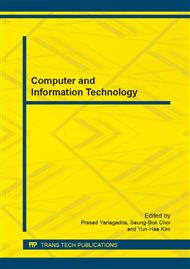[1]
Ansari D: Nature Reviews Neuroscience, 9(4): 278-291, (2008).
Google Scholar
[2]
Ansari D and Dhital B: Journal of Cognitive Neuroscience, 18(11): 1820-1828, (2006).
Google Scholar
[3]
Ansari D, Garcia N, Lucas E, Hamon K, and Dhital B: Neuroreport, 16(17): 1769-1773, (2005).
DOI: 10.1097/01.wnr.0000183905.23396.f1
Google Scholar
[4]
Cabeza R, Ciaramelli E, and Moscovitch M: Trends in cognitive sciences, 16( 6): 338-352, (2012).
DOI: 10.1016/j.tics.2012.04.008
Google Scholar
[5]
Cantlon JF, Brannon EM, Carter EJ, and Pelphrey KA: PLoS Biology, 4(5): e125, (2006).
Google Scholar
[6]
Cantlon JF, Libertus ME, Pinel P, Dehaene S, Brannon EM, and Pelphrey KA: Journal of Cognitive Neuroscience, 21(11): 2217-2229, (2009).
DOI: 10.1162/jocn.2008.21159
Google Scholar
[7]
Cutini S, Scarpa F, Scatturin P, Dell'Acqua R, and Zorzi M: Cerebral Cortex, in press.
Google Scholar
[8]
Dehaene S: Trends in cognitive sciences, 7(4): 145-147, (2003).
Google Scholar
[9]
Dehaene S, Bossini S, and Giraux P: Journal of Experimental Psychology General, 122(3): 371-371, (1993).
DOI: 10.1037/0096-3445.122.3.371
Google Scholar
[10]
Dehaene S and Brannon EM: Academic Press, (2011).
Google Scholar
[11]
Dehaene S and Cohen L: Mathematical cognition, 1: 83-120, (1996).
Google Scholar
[12]
Dehaene S, Molko N, Cohen L, and Wilson AJ: Current Opinion in Neurobiology, 14(2): 218-224, (2004).
DOI: 10.1016/j.conb.2004.03.008
Google Scholar
[13]
Dehaene S, Piazza M, Pinel P, and Cohen L: Cognitive Neuropsychology, 20(3): 487-506, (2003).
DOI: 10.1080/02643290244000239
Google Scholar
[14]
Ericsson KA and Kintsch W: Psychological Review, 102(2): 211 , (1995).
Google Scholar
[15]
Hanakawa T, Honda M, Okada T, Fukuyama H, and Shibasaki H: Neuroimage, 19(2): 296-307, (2003).
DOI: 10.1016/s1053-8119(03)00050-8
Google Scholar
[16]
Heine A, Wißmann J, Tamm S, De Smedt B, Schneider M, Stern E, et al: Cortex, 49(8): 2162-2177, (2013).
DOI: 10.1016/j.cortex.2012.11.009
Google Scholar
[17]
Holloway ID and Ansari D: Journal of Experimental Child Psychology, 103(1): 17-29, (2009).
Google Scholar
[18]
Holloway ID, Price GR, and Ansari D: Neuroimage, 49(1): 1006-1017, (2010).
Google Scholar
[19]
Isaacs E, Edmonds C, Lucas A, and Gadian D: Brain, 124(9): 1701-1707, (2001).
Google Scholar
[20]
Miller G: The psychological review, 63(2): 81-97, (1956).
Google Scholar
[21]
Mussolin C, De Volder A, Grandin C, Schlögel X, Nassogne M-C, and Noël M-P: Journal of Cognitive Neuroscience, 22(5): 860-874, (2010).
DOI: 10.1162/jocn.2009.21237
Google Scholar
[22]
Pedrycz W. Knowledge-based clustering: from data to information granules. Wiley-Interscience, (2005).
Google Scholar
[23]
Pedrycz W: Computational Intelligence. Springer, 2013: 15-29.
Google Scholar
[24]
Pinel P, Piazza M, Le Bihan D, and Dehaene S: Neuron, 41(6): 983-993, (2004).
DOI: 10.1016/s0896-6273(04)00107-2
Google Scholar
[25]
Santens S, Roggeman C, Fias W, and Verguts T: Cerebral Cortex, 20(1): 77-88, (2010).
DOI: 10.1093/cercor/bhp080
Google Scholar
[26]
Sonamthiang S, Naruedomkul K, and Cercone N. Granular Concept Mapping and Applications. Rough Sets and Intelligent Systems-Professor Zdzisław Pawlak in Memoriam. Springer, 2013: 585-603.
DOI: 10.1007/978-3-642-30344-9_22
Google Scholar
[27]
Temple E and Posner MI: Proceedings of the National Academy of Sciences, 95(13): 7836-7841, (1998).
Google Scholar
[28]
Wei W, Chen C, Yang T, Zhang H, and Zhou X: Human Brain Mapping, in press, (2013).
Google Scholar
[29]
Woodbridge R, Chechlacz M, Humphreys GW, and Demeyere N: NeuroImage, 2: 143-150, (2013).
Google Scholar
[30]
Zadeh LA: Fuzzy sets and systems, 90(2): 111-127, (1997).
Google Scholar


